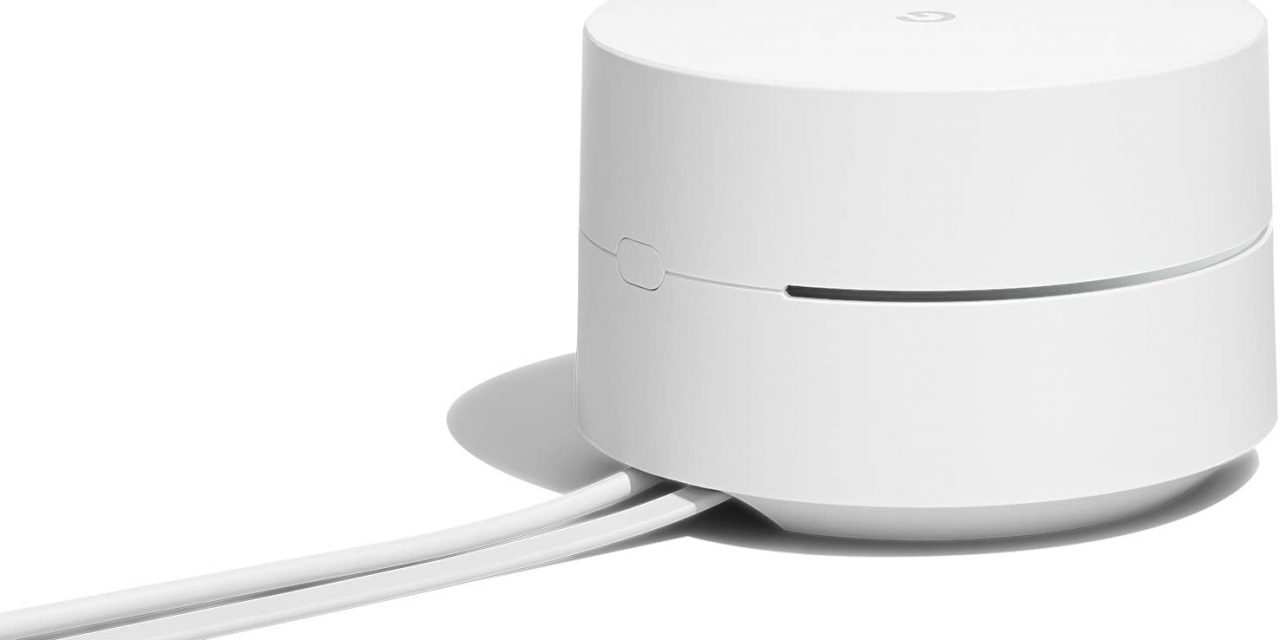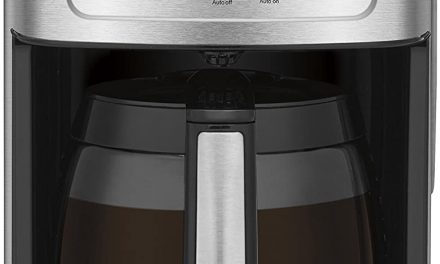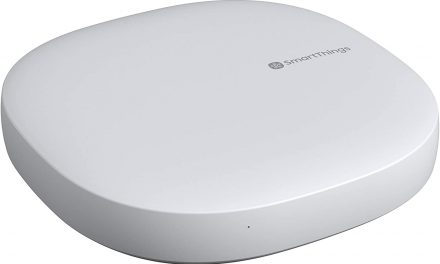Google manufactures some of the most popular smart routers on the smart router market. These aesthetically pleasing devices are fast, do not need any sort of subscription for you to use them and come with quite a good range. The Google WiFi comes with beamforming technology, has a modest range of up to 4500 sq. ft. depending on the number of nodes you use in the network and uses the popular WiFi 5 technology while the Onhub uses a powerful dual core 1.4 GHz processor, comes with Gigabit WAN and LAN port and has a whopping 4 GB of onboard flash memory. Which smart router is better than the other? We will compare the two smart routers head to head and help you to make a judgment as to which smart router is best for your home or office.
Alternatively, just skip to either the Google WiFi or the Onhub on Amazon.
Table of Contents
Quick Comparison Table Google WiFi vs Onhub
| Google WiFi | Onhub | |
|---|---|---|
| Image |  |  |
| Antennas | ||
| Frequency Bands Supported | 2.4 / 5 GHz | 2.4 / 5 GHz |
| Storage Capacity | 4 GB | 4 GB |
| Encryption Algorithm | WPA2-PSK | WPA2-PSK |
| Antennae | 5 | 13 |
| Range | 1500 – 4500 sq ft depending on the number of routers present | 2500 sq ft |
| Memory | 512 MB | 1 GB |
| Processor | Quad Core 710 MHz | Dual core 1.4 GHz |
| MU-MIMO | Absent | Absent |
| Beam forming | Present | Present |
| WiFi technology | WiFi 5 (IEE 801.11 a/b/g/n/ac) | WiFi 5 (IEE 801.11 a/b/g/n/ac) |
| Subscription Packages | None | None |
| Wired Connectivity | 2 Gigabit WAN + LAN USB type C | 2 Gigabit WAN & LAN and 1 USB 3.0 |
| Price | Check Price | Check Price |
Key similarities between the Google WiFi and the Onhub routers:
- Dual band routers
- Identical storage capacity
- Identical encryption algorithm
- Beam forming
- WiFi technology
Key differences between the Google WiFi and the Onhub routers:
- Processors
- Memory
- Number of antennae
- Cost
- Range
A Comprehensive Comparison between the Google WiFi router and the Onhub router
1. WiFi Bands
These are the frequency bands that the device is designed and developed to operate in. The WiFi technology uses 2 main frequency bands which are the 2.4 GHz band and the 5 GHz band. The main difference is that the 5 GHz band is less congested than the 2.4 GHz band as fewer devices use this band unlike the 2.4 GHz band which is used by Bluetooth, Zigbee, Microwaves, Cordless phones and other WiFi devices. Both routers support both bands. This is an advantage as there are some devices that do not support the 2.4 GHz band, and there are some that work best with the 5GHz band. This allows you to choose the band which best suits your needs.
2. Smart Hubs
Most modern homes make use of a smart hub. This allows you to carry out home automation. In this feature, you will be able to control your hub through the use of your smartphone, and the hub will then send signals to other devices connected to it. Both the Google WiFi and Onhub devices come with Local Area Network (LAN) ports. This allows for you to plug in controllers such as the Samsung SmartThings and Wink hub to these devices.
3. Subscription
It is quite normal for you to have routers and mesh networks that require you to have a subscription package. This package is needed in order for you to access the full features of the device. Such features include parental controls or advanced security capabilities. Both the Google WiFi and the Onhub do not require you to pay for any additional subscriptions. All you need to do is pay your money for the purchase and that’s it.
4. Setup
There is nothing that is more frustrating than buying a device that is difficult to use. You will end up having to search for experts who will then come and assist you. These devices are not difficult to setup. All you need to do is to create a Google account for you to use the Onhub device. Setting up the Onhub device is very easy. All you need to do is to download the Google On application which is available on both the Android and iOS platforms. The setup process is very easy and any average Joe can finish it without any challenges at all. The Google WiFi router is no different. All you need to do is to install a mobile application that comes with the device and you are good to go.
5. Gigabit Ports
Both the Google WiFi and the Onhub come with gigabit ports. The Google WiFi comes with two Ethernet ports per WiFi point. You can use one of the ports to a modem. It also has a USB type C port that can be used to power the device. The Onhub has 1 WAN, 1 LAN and 1 USB 3.0 port. These are great for really small setups but are not ideal for situations in which multiple devices need to be connected to the LAN network.
6. Dead Zones
The Google WiFi and the Onhub routers are able to reduce WiFi dead zones. This allows for you to maintain the same connection wherever you are in the house. This means that you will not have to run around your house just for you to get a decent signal. You can also shift the router to a more favorable location. There are apps that available to prevent the signal from dropping off completely. These automatically adjust the location of your router when the signal starts dropping. Such apps are WiFi Sweetspots for IOS and WiFi Analyzer for Android.
7. Performance
This is where the Google WiFi and the Onhub are different. The Google WiFi router is able to deliver a combined throughput of 465.4 megabits which can be delivered at a range of 5 feet. At 50 feet it stops at 389.7 megabits. The Onhub router supports a throughput of 1.9 gigabits at its peak. However, this is just a theoretical throughput. In practice, the throughput can be around 265.3 megabits. This is much lower than the Google WiFi router. As a result, the Onhub is not the best choice when you are considering smart WiFi devices.
8. Antennas
The Google WiFi and the Onhub come with a different number of antennae. The Google WiFi device comes with 5 antennae. Four of the antennas are for WiFi and the fifth one is used for Bluetooth. The Onhub comes with an impressive 13 antennas. They are placed in a circle around the interior of the router with six being used for the 5 GHz band and the other 6 for the 2.4 GHz band. The last one is used for signal boosting. If you did a bit of mathematics, you will notice that there are 2 extra antennae left. These antennae were for Bluetooth and ZigBee support but these technologies are not supported anymore. As a result, they are of no use at all.
9. Ram, CPU and Memory
The Google WiFi router comes with a quad core Advanced RISC Machine Central Processing Unit (ARM CPU). This is the latest technology in embedded computing and this makes the device operate at lightning speeds. Each core can run at 710 MHz. it has 512 MB of Ram. It also comes with 4GB of flash memory. The Onhub comes with a dual core 1.4 GHz qualcomm processor. It comes with 1 GB of memory. It as a flash memory of 4GB. While the Onhub may seem to have more impressive hardware, it does not appear to operate as smoothly as that of the Google WiFi router.
10. Range
The Onhub comes with a range of 2500 square feet. This looks impressive, but do bear in mind that there is no room for expansion. The Google WiFi router allows for you to integrate multiple units. Each unit has a range of between 500 and 1500 feet. This allows for you to increase your range to suit your needs. If you have a large property, you will need 3 WiFi units. These units will provide a total coverage of 4500 square feet. In addition to all this, the Onhub can be integrated into a Google WiFi system.
11. Nightlight
This is a feature that only comes with the Onhub. This is not the usual nightlight that you are used to. This nightlight allows for you to adjust the lights present. These lights can be adjusted to be bright to illuminate a small area. It can also set the device to automatically turn on or off depending on the ambient lighting because the device comes with a light sensor.
12. Design
The designs of the two routers are very different. The Google WiFi is quite small and is very well designed. It comes with a fingerprint resistant case and a glossy white finish. It is quite lightweight coming at a weight of just 12 ounces. This makes it easy to place it virtually anywhere. The Onhub on the other hand was made to be eye candy. It comes with a very attractive design and it looks like an artistic sculpture.
13. Additional features
The Google WiFi device allows for you use accessories to offer more flexibility and control especially during the installation process. An example of such devices are the Google Router Mounting brackets as well as the Google WiFi wall outlet mount. The Onhub allows for you to add shells .These allow for you to make the device look stylish and make it blend in with your home’s décor quite well. In addition, the Onhub comes with a speaker that comes on top of the device. It is a very nice feature, but it does not seem to have a lot of practical use.
Our Pick
We fell in love with the Google WiFi router. This is because of the host of features that it comes with. The design is quite lovely and it will easily blend into any home or office setting. It offers very fast speeds which will a very pleasurable experience to whoever uses it. It allows for you to extend it by adding more routers and make your range even wider. In addition to all this, it is very easy to setup and install.
Why Do You Need a Smart Router?
1. Easy to Setup
Smart routers are very easy to setup. The Google WiFi and the Onhub are examples, and they are so easy to setup that virtually anyone who is computer literate will be able to install and set them up with great ease.
2. Smart Home Support
The smart routers usually support features such as smart home support. This allows you to take your home automation to the next level and this provides added convenience. In addition, it makes your house look and feel modern.
3. Latest WiFi Technology
The smart routers that we reviewed support dual band WiFi radio. This feature allows you to select the least congested band and the most convenient one for you. In addition, they come with WiFi 5 which is one of the most popular WiFi technologies available on the market today.
Factors to Consider When Choosing between the Google WiFi and the Onhub
1. Range
You need to have a look at the size of the area in which you would want to use the router. If you want to use it in a big apartment, then go for the Google WiFi router. It allows for you to add on other routers to increase the range. If you are in a moderate size apartment then the Onhub may suffice.
2. Performance
If you want rock solid performance then go for the Google WiFi. It may have slightly inferior hardware when compared with the Onhub, but its performance is nowhere near that of the Onhub.
3. Nightlight
The Onhub comes with a light sensor which allows for it to become an extra light. This feature is quite handy and will be very useful if you want an extra light in the location where you want to place the router.
4. Speaker
The Onhub comes with a speaker which allows you to get a sound notification once somebody tries to join your wireless network. If you find this feature important to you then by all means go for the Onhub.
5. Accessories
The different routers have different accessories. The Onhub has accessories that make it look rather stylish. The Google WiFi device has mounting brackets to help offer more flexibility and control during the installation process. Choose the router which best suits your needs.
Google WiFi vs. Onhub FAQs
Will they Work with my Router?
Yes. Definitely.
Does Google Track my Private Information?
No. Google promises not to track any private information. We hope that they do keep to their promise.
Can I Create a Mesh Network?
If you are using the Google WiFi device then yes. You can create a mesh network. You can also use the Onhub device with the Google WiFi router to make a mesh network.
Does Google WiFi Work as a Range Extender?
Unfortunately, no. You cannot use it as a range extender.
How Many Devices Can I Connect to the Onhub?
You can connect several devices to it. We are quite confident that you can get up to 100 devices connected to the Onhub router.
Conclusion
In this article, we explored the similarities and the differences that are present between the Google WiFi and the Onhub routers. We declared the winner between the two to be the Google WiFi device. This is due to its rock solid performance, the very impressive range as well as the range extension capabilities that come with the router as well as the fact that the installation process is so simple that any tech literate person can set it up with great ease.
We included a comprehensive list of features that you would need to consider when choosing between the two routers. This will help you to choose the best device for your unique needs. Check out the best router, the Google WiFi on Amazon.






